Key takeaways:
- Pollinators like bees and butterflies are vital for biodiversity and over a third of global food supply, emphasizing their crucial roles in ecosystems.
- Creating diverse habitats with varied plant species, seasonal blooms, and water sources supports pollinator populations and fosters vibrant ecosystems.
- Implementing sustainable practices such as organic fertilizers, water conservation, and companion planting enhances garden health while benefiting pollinators.
- Community education through workshops and hands-on activities fosters engagement and collective action for pollinator health and local environmental initiatives.
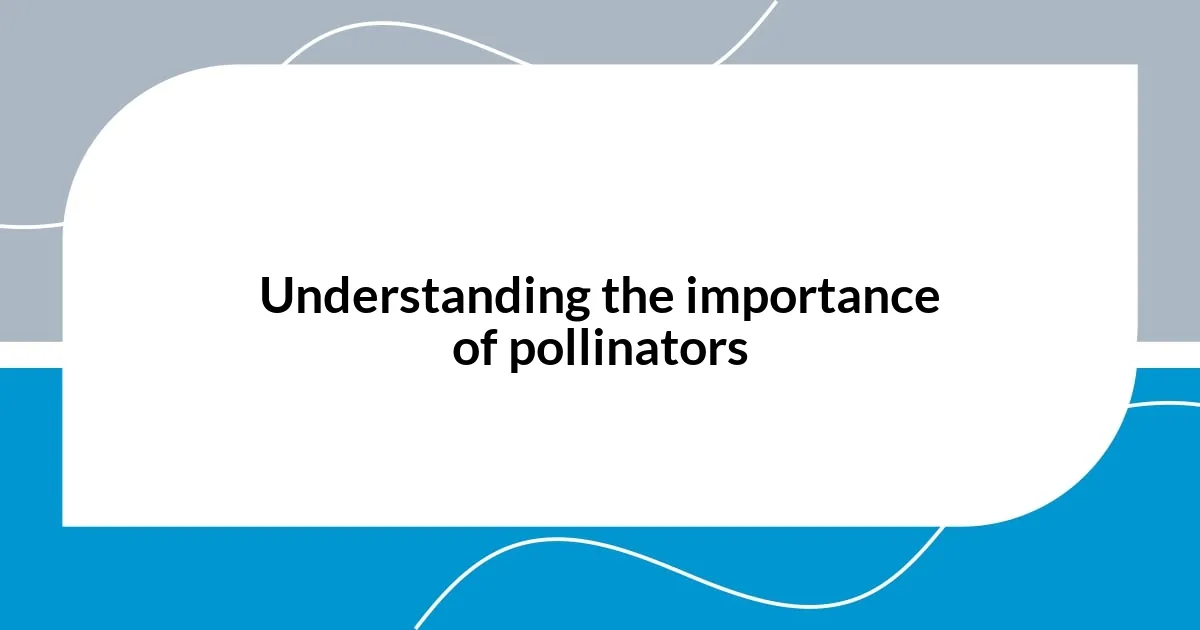
Understanding the importance of pollinators
Pollinators, like bees and butterflies, play an absolutely crucial role in our ecosystems. I still remember my first encounter with a hummingbird flitting around my garden; it sparked my interest in how these tiny creatures contribute to the world. Without them, many of the plants we cherish would struggle to reproduce, leading to a significant drop in biodiversity.
Have you ever thought about how much of our food relies on these creatures? From the fruits we love to the nuts we enjoy, over a third of the global food supply depends on pollinators. It’s astonishing to think that something so small can have such a gigantic impact—witnessing the process firsthand when I planted my first garden truly opened my eyes.
The decline of pollinator populations has serious implications for our food systems and natural habitats. I often find myself reflecting on the vibrant colors of a bee-covered wildflower—each little pollinator hard at work. It’s a reminder that supporting these essential creatures can transform our gardening spaces into thriving ecosystems filled with life.
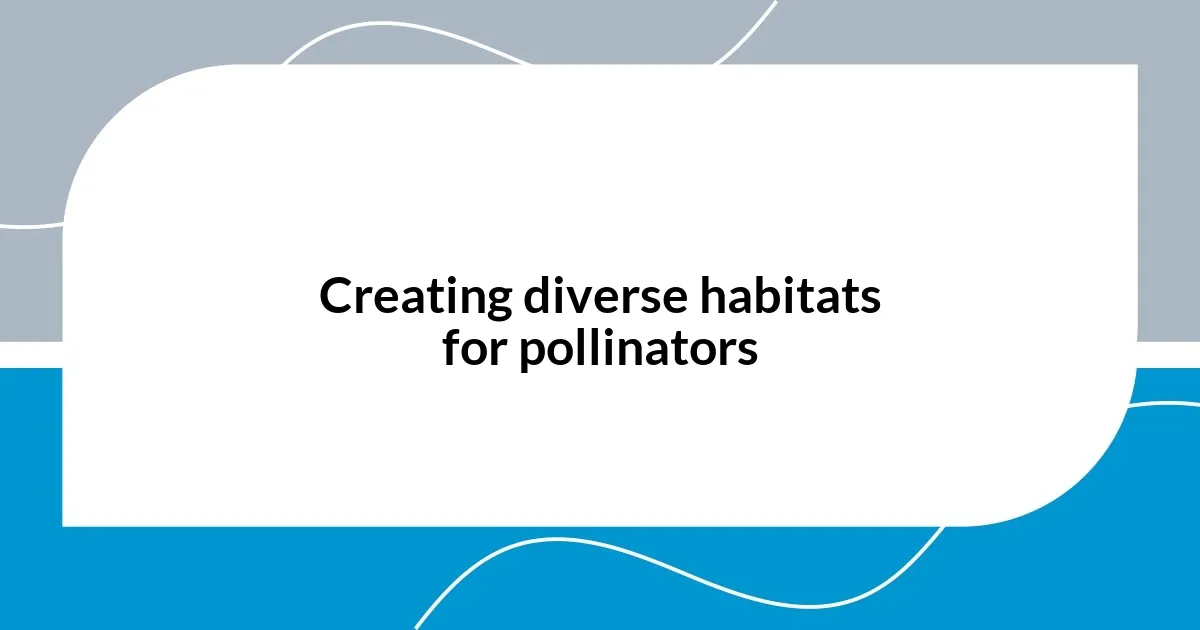
Creating diverse habitats for pollinators
Creating diverse habitats for pollinators can be a game changer in your garden. I remember visiting a community garden where every inch was bursting with a variety of plants, each selected to attract different pollinators. It was incredible to witness bumblebees darting between lavender spikes while butterflies danced around the zinnias. That experience made me realize how important it is to incorporate a mix of flowers, shrubs, and even native grasses into our spaces.
To create this rich tapestry of habitat, consider the following elements:
- Varied Plant Species: Include a mix of native and non-native plants that flower at different times to provide a continuous food source.
- Layered Structure: Introduce ground cover, low-lying plants, and taller flowering structures to provide nesting sites and shelter.
- Seasonal Variety: Plant flowers that bloom in spring, summer, and fall to support pollinators year-round.
- Soil Diversity: Create areas with different soil types to support various plant species and encourage diverse pollinator visits.
- Water Sources: Add shallow water dishes or small ponds to provide hydration for thirsty pollinators.
By intentionally designing your garden this way, you not only foster a vibrant ecosystem but also create a captivating space for yourself and the community. It’s a beautiful reminder that when you cultivate diversity, life flourishes.
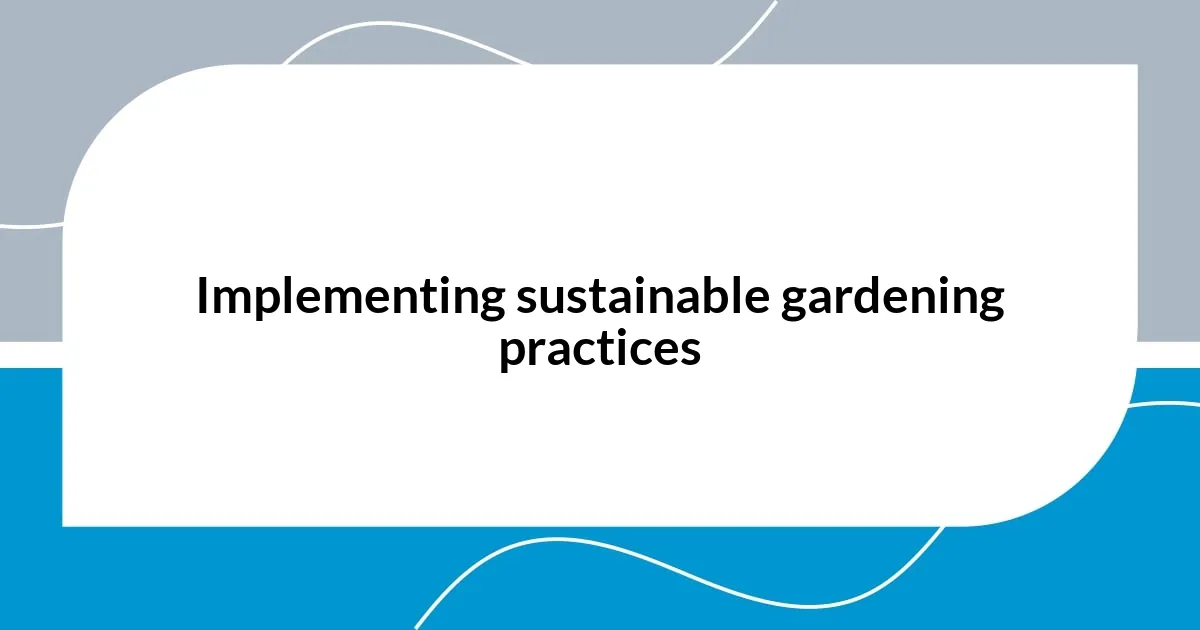
Implementing sustainable gardening practices
Implementing sustainable gardening practices can be incredibly rewarding. From my experience, I found that the best approach involves focusing on organic methods. For instance, using natural fertilizers instead of synthetic ones not only nurtures the soil but also attracts beneficial insects. I remember my initial hesitation to give up chemical treatments, but once I saw the difference in plant health and the increase in pollinator activity, it solidified my commitment.
Another key practice is water conservation. I started using rain barrels to collect runoff, which has allowed me to water my garden while conserving precious resources. Plus, the added bonus is that my plants seem to thrive! It’s amazing how something as simple as collecting rainwater can make a significant impact.
Lastly, I engage in companion planting, where specific plant combinations enhance growth and deter pests. For example, having marigolds alongside my vegetables created a vibrant colorscape and kept aphids at bay. I recall planting those marigolds late one evening, and the next morning, I was surprised to see a whole group of ladybugs drawn in by the colorful blooms. This interconnectedness gives me hope that small actions can nurture both our gardens and the environment.
| Sustainable Practice | Benefits |
|---|---|
| Organic Fertilizers | Enhances soil health and attracts beneficial insects |
| Water Conservation | Reduces water use and improves plant vitality |
| Companion Planting | Promotes growth and controls pests naturally |
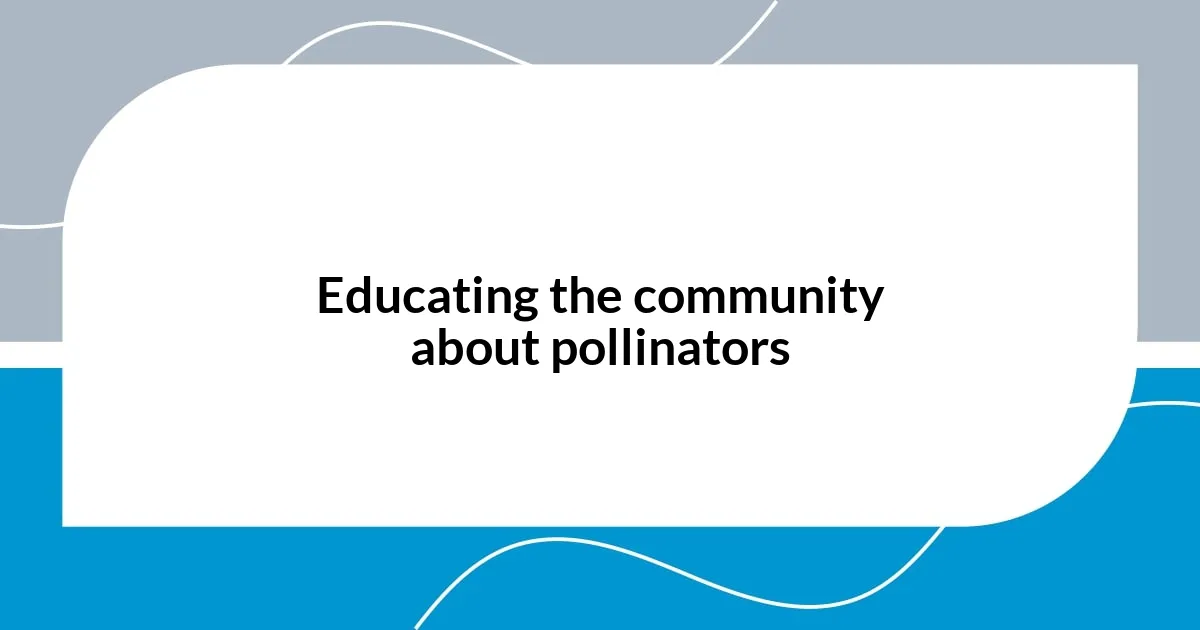
Educating the community about pollinators
Educating the community about pollinators is something I feel passionately about. A few months back, I organized a workshop at the local community garden where we talked about the significance of these tiny creatures. I shared how simple actions, like planting native flowers, can create a ripple effect in supporting the ecosystem. Have you ever noticed how a butterfly’s gentle flutter can brighten your day? Imagine if we could increase their numbers just by enhancing our green spaces!
I’ve also found that creating engaging visuals can make a big difference. During another event, I set up a colorful display featuring different pollinator species and their preferred plants. People were intrigued! I remember watching a young girl’s eyes widen when she learned that not all bees are the same. It was a beautiful moment when she exclaimed, “So, I can plant flowers that help those fuzzy bumblebees!” It truly highlighted how education can ignite curiosity and inspire action.
Another effective strategy I’ve utilized is hands-on activities. For instance, we built simple bee hotels together during one of our meetups. Not only did we discuss their importance for solitary bees, but we also crafted these structures while chatting about how everyone can contribute to pollinator health. Seeing community members eagerly working with their hands fostered a sense of connection. Have you ever participated in a project that felt satisfying not just for the outcome but for bringing people together? It’s experiences like this that can strengthen community bonds while improving our environment.
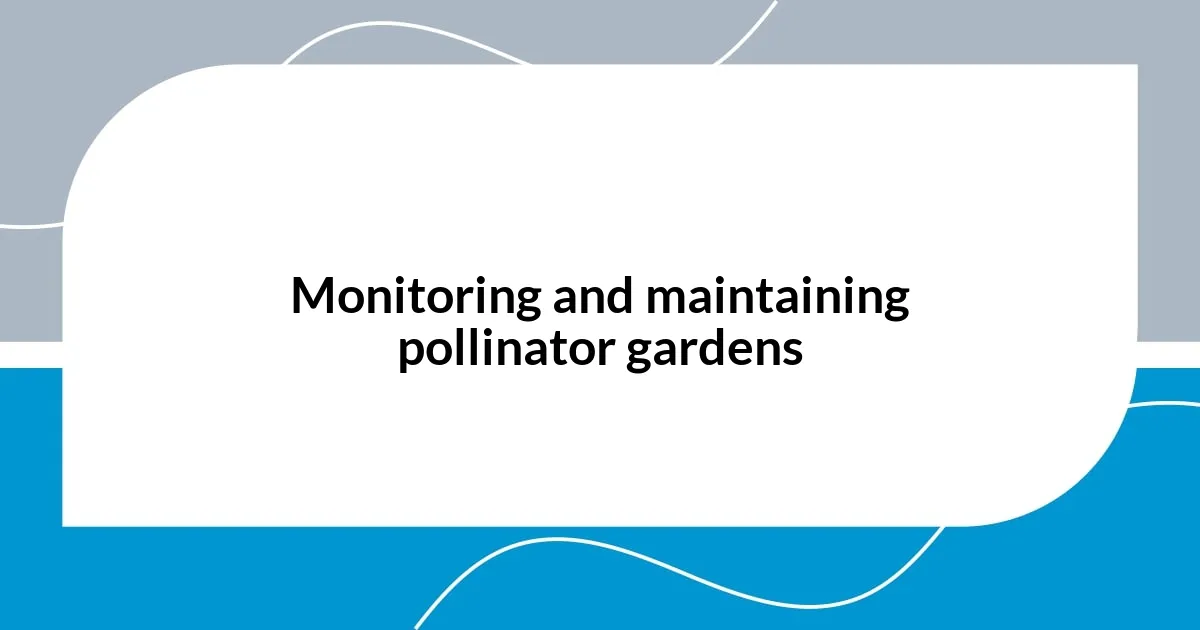
Monitoring and maintaining pollinator gardens
Monitoring a pollinator garden is essential to ensuring its health and vitality. I’ve often taken time to walk through my garden, observing which plants are thriving and where pollinator activity is highest. This simple routine allows me to notice patterns; for instance, I find that certain flowers like milkweed attract more butterflies when in full bloom. Have you ever watched a butterfly dance from flower to flower? It’s mesmerizing and a reminder that my efforts are making an impact.
Maintaining the garden involves understanding the balance of life within it. I committed to regular weeding and deadheading, which keeps the garden looking tidy and encourages blooming. One evening, while I was removing spent blossoms, I stumbled upon a tiny and vibrant hummingbird moth resting on a flower. It was such a joyful surprise! In that moment, I realized that my dedication to maintenance directly contributes to the habitat that supports these wonderful creatures.
Another critical aspect of monitoring involves keeping an eye on soil health. I usually conduct a periodic soil test to check for nutrient levels and pH balance, as these factors greatly influence plant growth and pollinator attraction. Last summer, I was slightly worried when my flowers didn’t bloom as vibrantly as they had in previous years, prompting me to investigate. After adjusting the soil, I noticed a remarkable turnaround—more blooms and more buzzing bees! It was a rewarding experience that underscored how attentive care can enhance the beauty and life of a pollinator garden. Have you ever graphed a comeback like that? There’s something truly fulfilling about seeing your efforts reflected in nature’s response.
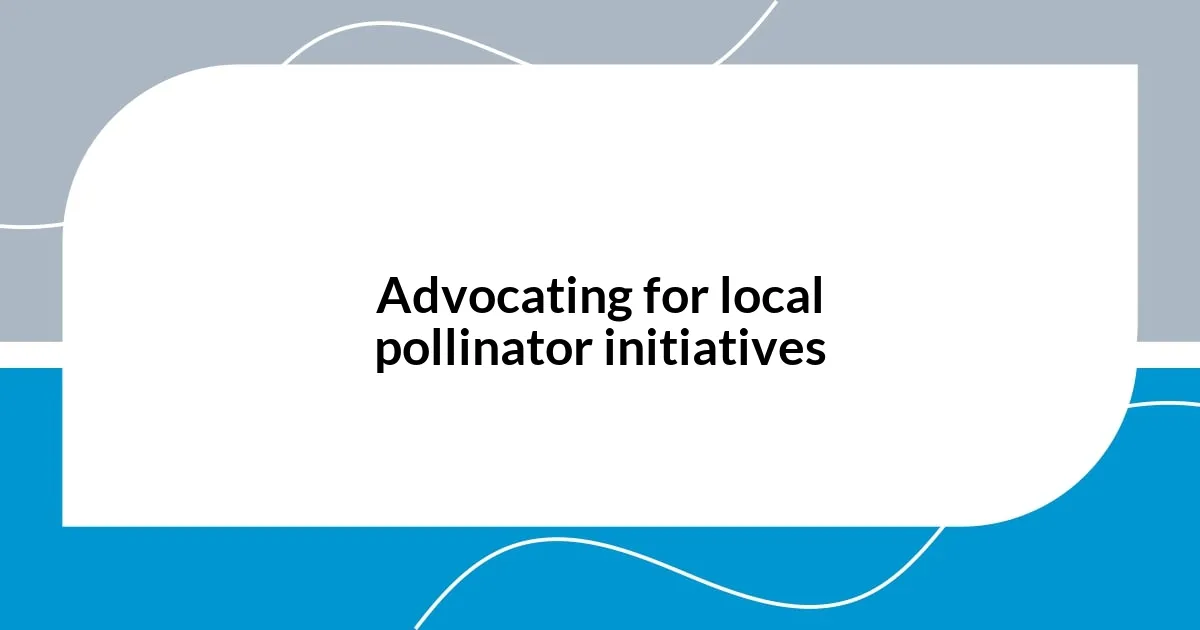
Advocating for local pollinator initiatives
Advocating for local pollinator initiatives can be an enriching experience. I recall attending a city council meeting last year where I passionately presented the benefits of establishing public pollinator gardens. Listening to the murmurs of curiosity and support from the audience gave me a sense of hope. Have you ever felt the electric energy of persuading others to envision a better community, where flowers overflow with life? That moment inspired me to dive deeper into local advocacy.
Connecting with community members is crucial when advocating for these initiatives. In my case, I facilitated a neighborhood gathering where we brainstormed ideas on transforming underused spaces into vibrant habitats for pollinators. I never expected to feel so energized by everyone’s creativity and enthusiasm. Hearing someone propose a butterfly waystation, complete with native plants and educational signage, filled me with pride. Have you ever shared a dream with others and watched it transform into a shared vision? It’s a powerful reminder that community-driven efforts can lead to tangible changes.
I believe collaboration with local schools can amplify advocacy efforts too. One afternoon, I visited a primary school to discuss how students could participate in creating a pollinator garden on campus. The students’ eagerness to learn and design the space amazed me! I watched them sketch out their ideas, and when one child suggested naming it “Butterfly Bay,” I couldn’t help but smile. Inspiration flows both ways, doesn’t it? Engaging young minds is not just about building gardens but also cultivating future stewards of the environment.